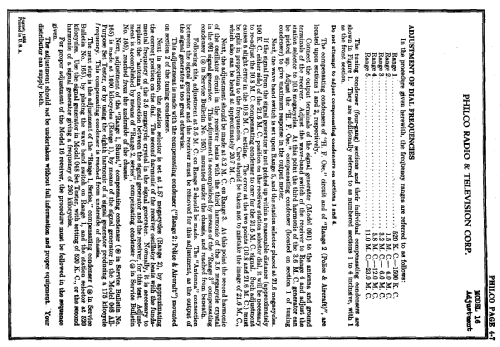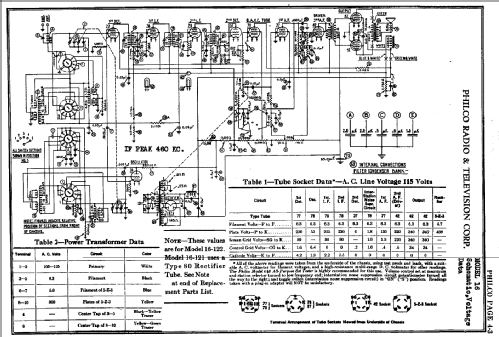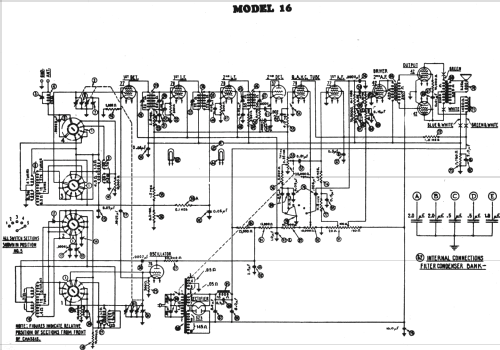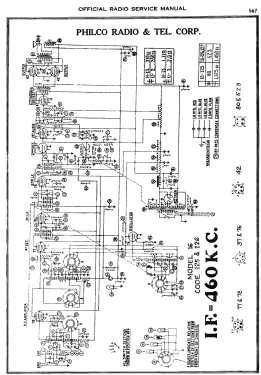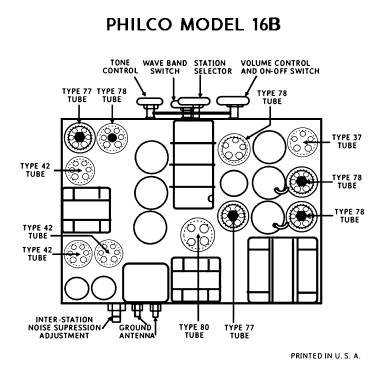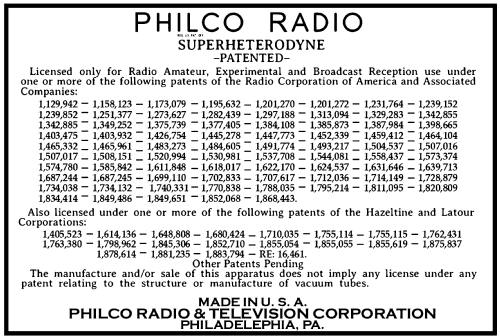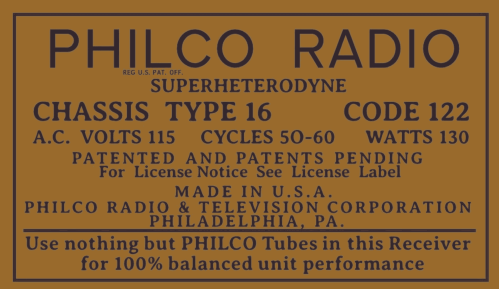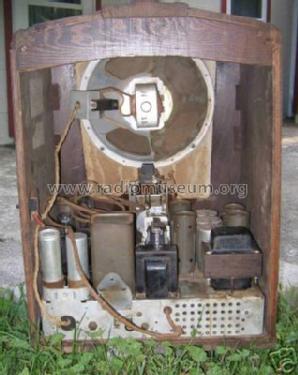16B 16/16A-121 Version 2
Philco, Philadelphia Stg. Batt. Co.; USA
- Pays
- Etats-Unis
- Fabricant / Marque
- Philco, Philadelphia Stg. Batt. Co.; USA
- Année
- 1934
- Catégorie
- Radio - ou tuner d'après la guerre 1939-45
- Radiomuseum.org ID
- 118867
Cliquez sur la vignette du schéma pour le demander en tant que document gratuit.
- No. de tubes
- 11
- Principe général
- Super hétérodyne (en général); FI/IF 460 kHz
- Gammes d'ondes
- PO et plus que 2 x OC
- Tension / type courant
- Alimentation Courant Alternatif (CA) / 115 Volt
- Haut-parleur
- HP dynamique à électro-aimant (électrodynamique) / Ø 10 inch = 25.4 cm
- Puissance de sortie
- 10 W (qualité inconnue)
- Matière
- Boitier en bois
- De Radiomuseum.org
- Modèle: 16B 16/16A-121 [Version 2] - Philco, Philadelphia Stg. Batt
- Forme
- Modèle de table vertical décoré (pierre tombale)
- Dimensions (LHP)
- 16.5 x 21 x 11 inch / 419 x 533 x 279 mm
- Remarques
-
The 2nd version of the Philco 16B was introduced in June, 1934. The cabinet has a shallow peaked top with 3 narrow bars running from the front of the cabinet to the back along the peak. It uses the code 121 early chassis.
The model 16 series were high-end multi-band 11-tube radios sold by Philco for about 2 years spanning the 1933, 1934, and 1935 model years. There were two basic versions of the chassis referred to as 'early' and 'late'. Both the early and late chassis used a type 80 rectifier tube for the 16B table models, and a 5Z3 rectifier for the console models. Both chassis included dual IF-amp stages and a shadow meter (tuning aid). Both chassis were available in a version for 25-40 Hz power, and these chassis are marked as "16A" (where the -A suffix is a chassis suffix, not to be confused with the cabinet suffix on the main model number).
The early chassis used in 1933-34 included a QAVC ("quiet automatic volume control") squelch circuit to silence noise between stations. Squelch was implemented with a dedicated type 78 tube, and controlled with an on/off switch on the side and a potentiometer on the back to adjust the squelch level. The early chassis received five bands: 520-1500 kHz, 1.5-4.0 MHz, 3.2-6.0 MHz, 5.8-12.0 MHz and 11.0-23.0 MHz.
The late chassis (1934-35) eliminated the QAVC feature and repurposed its 78 tube to be an RF amplifier stage in the front end, thus maintaining the 11-tube count. The switch on the side of the cabinet was used as a bass-boost control called "Loudness". The late chassis covered a similar tuning range, but with only four bands: 550-1500 KHz, 1.5-4.1 MHz, 4.1-10.0 MHz, and 10.0-22.5 MHz.
The chassis codes are as follows:
Code 121: early chassis with 80
Code 122: early chassis with 5Z3
Code 123: unknown
Code 125: late chassis with 80
Code 126: late chassis with 5Z3
Code 127: unknown
There were fifteen versions of model 16 in different cabinet styles over the three-model-year span:
Four versions of the 16B cathedral/tombstone,
Three versions of the 16L lowboy console,
Four versions of the 16X floor-type console,
Three versions of the 16RX chairside,
A special 16CPX chairside.
- Poids net
- 19 kg / 41 lb 13.6 oz (41.85 lb)
- Prix de mise sur le marché
- 90.00 $
- Source
- Philco Radio 1928-1942
- Source du schéma
- Rider's Perpetual, Volume 4 = ca. 1934 and before
- Schémathèque (1)
- Machine Age to Jet Age II (Philco 1928-36 Wiring Diagrams, Parts Lists, and Essential Service Data)
- Auteur
- Modèle crée par Konrad Birkner † 12.08.2014. Voir les propositions de modification pour les contributeurs supplémentaires.
- D'autres Modèles
-
Vous pourrez trouver sous ce lien 4120 modèles d'appareils, 2227 avec des images et 3768 avec des schémas.
Tous les appareils de Philco, Philadelphia Stg. Batt. Co.; USA

